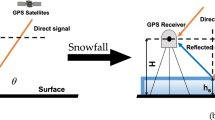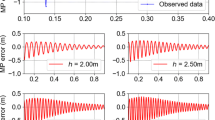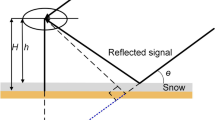Abstract
The Global Navigation Satellite Systems (GNSS) continuously broadcast radio signals at two or more frequencies in the L-band, providing extensive data for GNSS multipath reflectometry. Multi-GNSS constellations provide more signals and more tracks than individual constellations, achieving greater azimuthal coverage and more frequent retrievals. The main aim of this study is to retrieve snow depth using multi-GNSS data, analyze the multi-GNSS retrievals, and then combine them. Data of four constellations from three GNSS sites are analyzed, including the BeiDou and Galileo signals, which are rarely used to retrieve snow depth. The snow depth retrievals are estimated for signal-to-noise ratio data of each signal at first. The retrievals of individual signals from four constellations, except that of the GPS P-code signal, have no detectable inter-signal bias, thus showing the same trend describing snow depth variation. Then a multi-GNSS combination method based on robust regression is used to combine the inter-constellation inter-signal retrievals, and the multi-GNSS combined retrievals show an improvement in precision, availability, and temporal sampling. Compared to that of individual signals, it achieves about 50% improvement in precision, a smaller uncertainty, and a constant sampling interval of 6 h.









Similar content being viewed by others
Data availability
The GNSS data for FRDN and PRDS were provided by the International GNSS Service (IGS; https://www.igs.org). The snow depth retrievals were provided by the PBO H2O research group (https://xenon.colorado.edu/portal/). The XJJC GNSS station and ALTA snow depth record station are established and managed by both the local meteorological bureau and Chang’an University. The data of XJJC and ALTA are provided by the co-author Shuangcheng Zhang, working in Chang’an University, and co-author Lifu Wang, working in Altay meteorological bureau. Please ask the corresponding data to Shuangcheng Zhang if needed.
References
Boehm J, Schuh H (2004) Vienna mapping functions in VLBI analyses. Geophys Res Lett 31(1):L01603–L01606. https://doi.org/10.1029/2003GL018984
Boehm J, Werl B, Schuh H (2006) Troposphere mapping functions for GPS and very long baseline interferometry from European Centre for Medium-Range Weather Forecasts operational analysis data. J Geophys Res Solidid Earth 111(B2):B02406–B02414. https://doi.org/10.1029/2005JB003629
Böhm J, Möller G, Schindelegger M, Pain G, Weber R (2014) Development of an improved empirical model for slant delays in the troposphere (GPT2w). GPS Solut 19(3):433–441. https://doi.org/10.1007/s10291-014-0403-7
Estilow TW, Young AH, Robinson DA (2015) A long-term Northern Hemisphere snow cover extent data record for climate studies and monitoring. Earth Syst Sci Data 7(1):137–142. https://doi.org/10.5194/essd-7-137-2015
Holland PW, Welsch RE (1977) Robust regression using iteratively reweighted least-squares. Commun Stat Theory Methods 6(9):813–827. https://doi.org/10.1080/03610927708827533
Huang GW, Qin ZW, Zhang Q, Wang L, Yan XY, Fan LH, Wang XL (2017) A real-time robust method to detect BeiDou GEO/IGSO Orbital Maneuvers. Sensors 17(12):2761–2777. https://doi.org/10.3390/s17122761
Huber PJ (1981) Robust statistics. Wiley, Hoboken, NJ
Jin SG, Qian XD, Kutoglu H (2016) Snow depth variations estimated from GPS-reflectometry: a case study in Alaska from L2P SNR data. Remote Sens 8(1):63–77. https://doi.org/10.3390/rs8010063
Jin SG, Qian XD, Wu X (2017) Sea level change from BeiDou navigation satellite system-reflectometry (BDS-R): first results and evaluation. Global Planet Change 149:20–25. https://doi.org/10.1016/j.gloplacha.2016.12.010
Larson KM, Nievinski FG (2013) GPS snow sensing: results from the EarthScope plate boundary observatory. GPS Solut 17(1):41–52. https://doi.org/10.1007/s10291-012-0259-7
Larson KM, Small EE (2016) Estimation of snow depth using L1 GPS signal-to-noise ratio data. IEEE J Sel Top Appl Earth Obs Remote Sens 9(10):4802–4808. https://doi.org/10.1109/JSTARS.2015.2508673
Larson KM, Gutmann ED, Zavorotny ZU, Braun JJ, Williams MW, Nievinski FG (2009) Can we measure snow depth with GPS receivers? Geophys Res Lett 36(17):L17502–L17506. https://doi.org/10.1029/2009GL039430
Larson KM, Ray RD, Nievinski FG, Freymueller JT (2013) The accidental tide gauge: a GPS reflection case study from Kachemak Bay, Alaska. IEEE Geosci Remote Sens Lett 10(5):1200–1204. https://doi.org/10.1109/LGRS.2012.2236075
Larson KM, Ray RD, Williams S (2017) A ten-year comparison of water levels measured with a geodetic GPS receiver versus a conventional tide gauge. J Atmos Oceanic Technol 34(2):295–307. https://doi.org/10.1175/JTECH-D-16-0101.1
Löfgren JS (2014) Haas R (2014) Sea level measurements using multi-frequency GPS and GLONASS observations. EURASIP J Adv Signal 1:1–13. https://doi.org/10.1186/1687-6180-2014-50
Lomb NR (1976) Least-squares frequency analysis of unequally spaced data. Astrophys Space Sci 39(2):447–262. https://doi.org/10.1007/BF00648343
Montenbruck O, Steigenberger P, Khachikyan R, Weber G, Langley RB, Mervart L, Hugentobler U (2013) IGS-MGEX: preparing the ground for multi-constellation GNSS science. In: Proceedings of the 4th international colloquium on scientific and fundamental aspects of the Galileo System, Prague, Czech Republic,4–6 December 2013
Montenbruck O et al (2017) The multi-GNSS experiment (MGEX) of the international GNSS service (IGS)—achievements propects and challenges. Adv Space Res 59(7):1671–1697. https://doi.org/10.1016/j.asr.2017.01.011
Nievinski FG, Larson KM (2014a) Inverse modeling of GPS multipath for snow depth estimation—Part I: formulation and simulations. IEEE Trans Geosci Remote Sens 52(10):6555–6563. https://doi.org/10.1109/TGRS.2013.2297681
Nievinski FG, Larson KM (2014b) Inverse modeling of GPS multipath for snow depth estimation—Part II: application and Validation. IEEE Trans Geosci Remote Sens 52(10):6564–6573. https://doi.org/10.1109/TGRS.2013.2297688
Nievinski FG, Silva MF, Boniface K, Monico JFG (2016) GPS Diffractive reflectometry: footprint of a coherent radio reflection inferred from the sensitivity kernel of multipath SNR. IEEE J Sel Topics Appl Earth Observ 9(10):4884–4891. https://doi.org/10.1109/JSTARS.2016.2579599
Roesler C, Larson KM (2018) Software tools for GNSS interferometric reflectometry (GNSS-IR). GPS Solut 22(3):1–10. https://doi.org/10.1007/s10291-018-0744-8
Roussel N, Ramillien G, Frappart F, Darrozes J, Gay A, Biancale R, Striebig N, Hanquiez V, Bertin X, Allain D (2015) Sea level monitoring and sea state estimate using a single geodetic receiver. Remote Sens Environ 171:261–277. https://doi.org/10.1016/j.rse.2015.10.011
Santamaría-Gómez A, Watson C (2016) Remote leveling of tide gauges using GNSS reflectometry: case study at spring bay. Aust GPS Solut 21(2):451–459. https://doi.org/10.1007/s10291-016-0537-x
Scargle JD (1982) Studies in astronomical time series analysis. II. Statistical aspects of spectral analysis of unevenly spaced data. Astrophys J 263:835–853. https://doi.org/10.1086/160554
Street JO, Carroll RJ, Ruppert D (1988) A note on computing robust regression estimates via iteratively reweighted least squares. Am Stat 42(2):152–154. https://doi.org/10.2307/2684491
Tabibi S, Geremia-Nievinski F, Dam TV, Monico JFG (2015) Assessment of modernized GPS L5 SNR for ground-based multipath reflectometry applications. Adv Space Res 55(4):1104–1116. https://doi.org/10.1016/j.asr.2014.11.019
Tabibi S, Geremia-Nievinski F, Dam TV (2017) Statistical comparison and combination of GPS, GLONASS, and Multi-GNSS multipath reflectometry applied to snow depth retrieval. IEEE Trans Geosci Remote Sens 55(7):3773–3785. https://doi.org/10.1109/TGRS.2017.2679899
Wang X, Zhang Q, Zhang S (2018a) Water levels measured with SNR using wavelet decomposition and Lomb-Scargle periodogram. GPS Solut 22(1):1–10. https://doi.org/10.1007/s10291-017-0684-8
Wang X, Zhang Q, Zhang S (2018b) Azimuth selection for sea level measurements using geodetic GPS receivers. Adv Space Res 61(6):1546–1557. https://doi.org/10.1016/j.asr.2018.01.002
Wang X, Zhang Q, Zhang S (2019a) Sea level estimation from SNR data of geodetic receivers using wavelet analysis. GPS Solut 23(1):1–14. https://doi.org/10.1007/s10291-018-0798-7
Wang X, He X, Zhang Q (2019b) Evaluation and combination of quad-constellation multi-GNSS multipath reflectometry applied to sea level retrieval. Remote Sens Environ 231:111229–111238. https://doi.org/10.1016/j.rse.2019.111229
Werner G, Lou E (2009) RINEX (The Receiver Independent Exchange Format) Version 3.01. ftp://igs.org/pub/data/format/rinex301.pdf
Williams SDP, Nievinski FG (2017) Tropospheric delays in ground-based GNSS multipath reflectometry—Experimental evidence from coastal sites. J Geophys Res Solid Earth 122(3):2310–2327. https://doi.org/10.1002/2016JB013612
Yang T, Wan W, Chen XW, Chu TX, Qiao Z, Liang H, Wei JH, Wang GQ, Hong Y (2019) Land surface characterization using BeiDou signal-to-noise ratio observations. GPS Solutions 23(2):1–12. https://doi.org/10.1007/s10291-019-0824-4
Zhang S, Wang X, Zhang Q (2017) Avoiding errors attributable to topography in GPS-IR snow depth retrievals. Adv Space Res 59(6):1663–1669. https://doi.org/10.1016/j.asr.2016.12.031
Zhou W, Liu LL, Huang LK, Yao YB, Chen J, Li SQ (2019) A new GPS snr-based combination approach for land surface snow depth monitoring. Sci Rep 9(1):3814–3820. https://doi.org/10.1038/s41598-019-40456-2
Acknowledgements
This work is supported by the Fundamental Research Funds for the Central Universities (B200202015), the Jiangsu Province Surveying Mapping and Geoinformation Research Project (JSCHKY201901), and the Natural Science Foundation of Jiangsu Province (BK20190496). The authors declare that they have no conflict of interest.
Author information
Authors and Affiliations
Corresponding authors
Additional information
Publisher's Note
Springer Nature remains neutral with regard to jurisdictional claims in published maps and institutional affiliations.
Rights and permissions
About this article
Cite this article
Wang, X., Zhang, S., Wang, L. et al. Analysis and combination of multi-GNSS snow depth retrievals in multipath reflectometry. GPS Solut 24, 77 (2020). https://doi.org/10.1007/s10291-020-00990-3
Received:
Accepted:
Published:
DOI: https://doi.org/10.1007/s10291-020-00990-3




